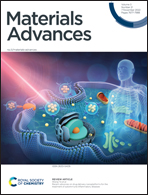Surface ligand engineering of perovskite nanocrystals with a conjugated sulfonate ligand for light-emitting applications†
Abstract
All-inorganic perovskite (CsPbX3, X = Cl, Br, or I) nanocrystals (NCs) with superior optical and optoelectronic properties are regarded as potential active materials for light-emitting applications. However, the commonly used insulating ligands such as oleylamine (OAm) and oleic acid (OA) with long hydrocarbon chains on the surface of perovskite NCs lead to low device performance of perovskite light-emitting diodes (PeLEDs). In this study, we introduced a new sulfonate ligand sodium beta-styrenesulfonate (SβSS) with elongated π-conjugation in the surface ligand engineering of CsPbBr3 NCs. The results show that the sulfonate ligand was successfully anchored on the surface of CsPbBr3 NCs, which can decrease the surface defects and improve the photoluminescence quantum yield (PLQY) from 53 to 75% compared with the pristine perovskite NCs. Moreover, its π-conjugation can also enhance the charge injection and transport capability. The optimized green PeLED based on the SβSS-modified CsPbBr3 NCs exhibited a maximum brightness of 10 965 cd m−2 and a maximum current efficiency of 10.9 cd A−1, revealing 2.5- and 2.4-fold enhancement compared with the device based on pristine NCs.



 Please wait while we load your content...
Please wait while we load your content...